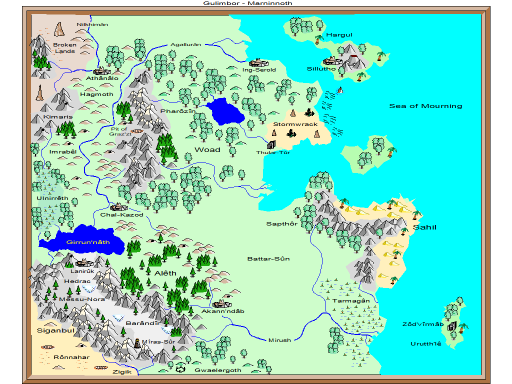
| Category | Wars | |||
| Period | 412 - 414 | |||
| Theater | Gulimbor | |||
| Belligerents |
| |||
| Map | Marninnoth |
Since the Demon Spawn War, Gulimbor's Imrabêl valley has been the home of the minotaurs.
These were "semi" civilized minotaurs. They were tribal people prone to barbaric activities like raiding and slaving. They fought among themselves as much as raiding the settlements of the humans of southern Gulimbor.
- Kana-Bran, excerpt from "Study of Early Peoples of the First Epoch"
By the fourth century of the First Epoch, there were thirteen minotaur tribes. The First Khazarkar Empire were expanding north from Chal-Kazod and the minotaurs of Imrabêl were in the path of the rapidly growing might of the Khazarkars. For two hundred years, the minotaurs raided the frontier settlements of northern Chal-Kazod. There were spells of peace and prosperity between the belligerents, but these never lasted more than a couple of years before the raiding and small battles started anew.
The First Khazarkar Empire started this war to claim the fertile lands of the Imrabêl valley. The minotaurs built their homes in the cliffs making them very defensible. They also had strong points spread across the mountain paths and hilltops. The only disadvantage they had was they were a chaotic lot that fought among themselves as much as they raided the town of Chal-Kazod and its northern villages and homes.
The Third Imrabêl War was another in a series of wars between the Tragarans, minotaurs, and Khazarkar of Gulimbor. The minotaurs fought to hold Imrabêl and push back their northern and southern neighbors, while the Khazarkar sought to dominate the valley and push north, and the Tragarans to open trade through the valley to the Khazarkar.
At the start of the Third Imrabêl War, there were 10,000 minotaurs in the valley. The Khazarkars started the Third Imrabêl War solely for territorial ambitions and not as some would think, to curb the raiding of the minotaurs. Khazarkar war strategists thought that capturing the valley would take less than four months of campaigning. The minotaurs cliff redoubts, fortified underground labyrinths and mazes dragged the war on for two years. At the end of the war, five thousands minotaurs were pressed into slavery. This slave population consisted more of youths and females than male adults. The minotaurs of "fighting age" were either too proud or stubborn, because very few surrendered even when far outnumbered or staring at imminent defeat.